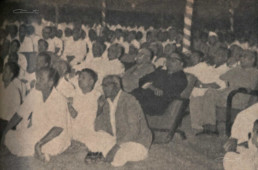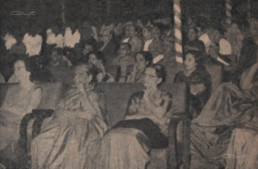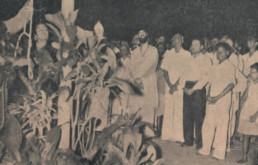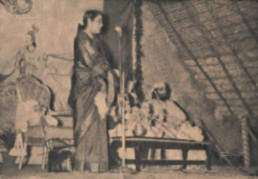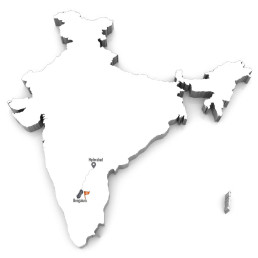
Jnana Yajna 96

Year & Dates:
October 31, 1961 to November 19, 1961

Yajna Topic:
Shrimad Bhagavad Gita- Chapter 13

Place:
Bengaluru, India
The 96th yajna of Pujya Gurudev’s, which was the sweet 7th opportunity for Bengaluru, was slated to be inaugurated only at 6:30 pm on the evening of October 31st. However, the aspiring audience began walking into the yajnashala even by 4 pm, demonstrating how both time and space became sacred commodities when Pujya Gurudev arrives in town. What He did in terms of redefining the sense of punctuality and inculcating an orderly outlook and format in performing a Jnana Yajna are a part of the valuable legacy of Chinmaya Mission.
In that 96th Yajna, the Om flag was hoisted by Smt. Malati Ramakrishna Rao, the president of the ladies’ yajna committee which had organized the 96th yajna. After welcoming Pujya Gurudev, she invited Sri. Kulapati Kanaiyalal Maneklal (K. M.) Munshi, a reputed lawyer and versatile scholar who founded the Bharatiya Vidya Bhavan in 1938, to inaugurate the yajna.
Experience of Peace Three-Fold
In her welcome address, Smt. Rao had drawn attention to the unceasing travel and incredible efforts that Pujya Gurudev put in weeding out the misinformation about Hinduism while fostering the logical approach to ancient Vedic philosophy. She added, “He has convinced us that we need not be sadhus or recluses to lead a spiritual life – that the path of divine life can be achieved and practiced in the midst of worldly affairs – that the impediments to such a life lie not outside us but within us.”
In his inaugural speech, Sri. Munshi shared about his tender and long association of 68 years with the “little book” of the Gita which had never failed to strengthen and inspire him. He called attention to how Indian culture survived for over 5000 years against many odds, and he emphasized that “vitality of India arises from the strength and spirit of our culture…culture is not a distinct way of life, but it is the spirit of man.” He outlined how the Gita helps to overcome the grip of ego, the ‘I-ness and My-ness,’when daily living itself turns into a jnana yajna. Through mindful balance, inspired work, and surrender to Bhagavan, success happens, he assured.
Pujya Gurudev reiterated the importance of Sadhana which is termed yoga in the Gita. He pointed out how 13th chapter gives a comprehensive and exhuastive insight to understand both the Field and the Knower so that a student of Gita can enter Gita, experience, conquer and live It subjectively.
The diverse public of Bengaluru also attended Pujya Gurudev’s Kaivalyopanishad discourses in the mornings. The response to the yajna organized in an exemplary manner by the all-ladies yajna committee was overwhelming. Even Pujya Gurudev expressed how He had felt a special sense of satisfaction in teaching, there, the Kshetra Kshetrajna Vibhaga Yoga, a chapter He had taught so many times before.
A Meditation Minute:
कल्याणशीतलकटाक्षनिरीक्षणेन तापत्रयप्रशमनैकपरं सुधीरम् ।
प्रज्ञानवारिधितरंगविहारलोलं श्रीचिन्मयं गुरुवरं हृदि भावयामि ॥ ७ ॥
kalyāṇaśītalakaṭākṣanirīkṣaṇena tāpatrayapraśamanaikaparaṃ sudhīram ।
prajñānavāridhitaraṃgavihāralolaṃ śrīcinmayaṃ guruvaraṃ hṛdi bhāvayāmi ॥ 7 ॥
“I meditate in my heart upon Śrī Chinmaya, the best of teachers of firm wisdom, who subdues the three human miseries (ādhibhautika, ādhidaivika, and ādhyātmika) by a mere soothing and auspicious glance, and who sports joyously upon the ocean of supreme wisdom.”
- Chinmaya Ashtakam verse 7
Pujya Gurudev’s conviction and faith in the scriptures was so firm that it visibly diffused through the thousands who walked into His yajnashalas. All afflictions – as He termed so concisely as “Seen, Unseen, and Within” would simply resolve in His Presence. His mere glance, even from His image or pratima after He attained Mahasamadhi, holds the power to quieten the agitations in the minds of millions.
To that curative and compassionate anchor, “Sri Chinmaya,” our heartfelt prostrations.
Photo Gallery

“Think,” Says Pujya Gurudev
When one has understood that the atoms are the physical units of matter one must also realize at once that these atoms in different combinations of numbers and patterns create the world of Infinite forms and qualities. Similarly, here to know that the Self is the ultimate Truth behind the names and forms is in itself only a partial knowledge. The complete understanding of Life can arise only when we at once understand how from the Self the endless multiplicity of names and forms rise up and spread to become the Universe.
Just as in our understanding we can comprehend all the waves as inherent in the ocean, so too a man of right understanding can recognize “the separate existence of all beings in the one”. Once having understood the ocean we would have also thereby realized how the numberless waves rise from that one ocean; so too a man of light understanding also realizes “the expansion of the plurality from that one alone”. Such moments of complete understanding wherein the Man of Wisdom experiences the one Self within and without-enveloping and enracing, penetrating and nourishing not only the depthless depths of the measureless Infinite, but also the superficial world of pluralistic names and forms-are the sacred moments when he has “become the Brahman”.
From Tyagi Magazine
Why it is difficult to realise God?
The Upanishadic statement elucidates the omnipresence and omniscience of the divine, perceiving and encompassing all existence, animate and inanimate. Despite the subtlety of this presence, it pervades every aspect of creation, manifesting as the indwelling essence within all beings and forms, while also transcending spatial limitations, being both farther than the farthest and nearer than the nearest.
